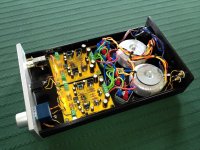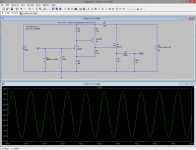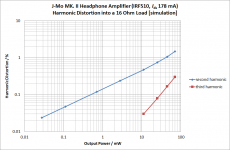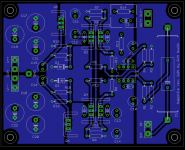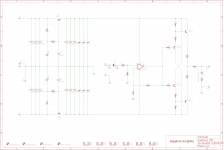rjm -
Interesting...
Is there anything special about the TDK ceramics you call out in your blog post??? I have quite a few Kemet ceramics (both C0G and X7R varieties); they should be ok shouldn't they???
Interesting...
Is there anything special about the TDK ceramics you call out in your blog post??? I have quite a few Kemet ceramics (both C0G and X7R varieties); they should be ok shouldn't they???
No, there is nothing special about them, they are standard x7r or the like, multilayer ceramics and anything similar should work just as well.
In order of good-better-best: X7R is not so good. COG is better and NPO is best as ceramics go. -RNM
In order of increasing temperature stability ... and price.
Did you or anyone ever test whether this was actually an important (read: audible) feature when using the capacitor in bypass (not signal coupling) applications? I have vague recollections of seeing hysteresis loops on scope traces in an article I read years ago. Was that yours?
Did you or anyone ever test whether this was actually an important (read: audible) feature when using the capacitor in bypass (not signal coupling) applications? I have vague recollections of seeing hysteresis loops on scope traces in an article I read years ago. Was that yours?
The work of Cyril Bateman. X7R, X5R, Z5U, Y5V distord very bad, only NPO-COG are adecuated for audio:
Capacitor Sounds, Speaker Cables and Crossover Inductors.
Capacitor Sounds, Speaker Cables and Crossover Inductors.
I guess what I'm asking is has anyone swapped X7R for NPO as bypass caps for an opamp and claimed to hear a significant improvement?
Many, many people and audio equipment manufacturers have heard changes reported over past several decades when bypassing on the power supply using differect cap dielectrics. I suspect it depends a lot on the circuits PSRR just how much affect it has. Many tube circuits seem to be more affected than IC's.
I recall one such audio bypass cap "tasting" test rated X7R bypass "better sounding" - at least while Blinding was in place
% distortion of the PS ripple shouldn't have much effect, only a very high Z PS ( == bad ) would let your circuit "see" bypass C dielectric effects at audio
% distortion of the PS ripple shouldn't have much effect, only a very high Z PS ( == bad ) would let your circuit "see" bypass C dielectric effects at audio
SE tube designs are not the usual place where one can find small smd capacitors 😀
However I'm wandering. How is it possible to hear a difference in an opamp circuit that has over 100dB of PSRR? 🙄 For PS bypass caps ner the IC pins I use X7R's and I'm perfectly happy with that. When I need a smd cap which is in the signal path I go straight to the film caps. Those are a bit expensive and bulky (most in 1206 or larger package). For the record - I don't have the golden years disease 😀
Just my 5 cents. Regards, Venci.
However I'm wandering. How is it possible to hear a difference in an opamp circuit that has over 100dB of PSRR? 🙄 For PS bypass caps ner the IC pins I use X7R's and I'm perfectly happy with that. When I need a smd cap which is in the signal path I go straight to the film caps. Those are a bit expensive and bulky (most in 1206 or larger package). For the record - I don't have the golden years disease 😀
Just my 5 cents. Regards, Venci.
It probably makes little difference... I havent listened, myself to that IC app you are describing. If it works for you, what else matters? I am saying - for readers here under a wide variety of conditions and circuits -that if you dont know what to do or what to use, go with the better caps rank listed to assure yourself of the best results.
The price difference isn't as great as I thought. 75 cents each for C0G vs. 25 cents for X7R (Mouser). Don't take that as an endorsement, mind you, just that people who are in the habit of paying $20+ for coupling caps might want to consider trying this "upgrade".
For bypass applications, I remain skeptical.
For bypass applications, I remain skeptical.
Photo of a recent Sapphire build. The chassis ground is a heavy screw mounted between the L and R rectifier banks and the transformers. The circuit common is connected to the chassis ground from the COM pads on the board.
This seems to be the best way to do it.
Note that there are a pair of COM pads on the boards, but the are electrically bridged. You can use one or the other or both, it doesn't matter, I just included two to make it convenient to connect two bridge rectifiers per channel.
If you have one pad spare, you can use it to ground the boards to the chassis.
The reason there in no explicit "GND" pad like the Phonoclone/VSPS boards have is I imagined most people might be using headphone sockets which have the COM ring (gnd) in electrical contact with the socket housing, which, for a metal front panel, grounds the circuit by default. As it turns out most people use insulated sockets and make the chassis-to-circuit-common connection elsewhere - in which case, I suggest the COM pad.
This seems to be the best way to do it.
Note that there are a pair of COM pads on the boards, but the are electrically bridged. You can use one or the other or both, it doesn't matter, I just included two to make it convenient to connect two bridge rectifiers per channel.
If you have one pad spare, you can use it to ground the boards to the chassis.
The reason there in no explicit "GND" pad like the Phonoclone/VSPS boards have is I imagined most people might be using headphone sockets which have the COM ring (gnd) in electrical contact with the socket housing, which, for a metal front panel, grounds the circuit by default. As it turns out most people use insulated sockets and make the chassis-to-circuit-common connection elsewhere - in which case, I suggest the COM pad.
Attachments
THD simulation for the BOM version of the J-Mo Mk. II, driving a 16 ohm load.
I mistakenly posted this to the wrong thread. It belongs in the J-Mo Mk. II thread instead, as a followup to this post.
Revision 2.0
This looks to be about the final revision before sending off for fabrication.
The new boards are drop in replacements for rev. 1.4s, and the circuit can default back to the original if desired.
The main changes are the addition of a Zobel network on board, ceramic bypass capacitors on board, and an additional pair of resistors to increase the bias current through the output transistors. The parts numbering has been completely changed, however, and I will be updating the documentation to reflect that.
There will be 9 sets of boards available, and will do a limited edition kit if the interest is there.
This looks to be about the final revision before sending off for fabrication.
The new boards are drop in replacements for rev. 1.4s, and the circuit can default back to the original if desired.
The main changes are the addition of a Zobel network on board, ceramic bypass capacitors on board, and an additional pair of resistors to increase the bias current through the output transistors. The parts numbering has been completely changed, however, and I will be updating the documentation to reflect that.
There will be 9 sets of boards available, and will do a limited edition kit if the interest is there.
Attachments
Whats the story on the zobel on the output Richard? Have you found it particularly beneficial with any cans in particular or either end of the impedance spectrum?
Fran
Fran
No, I can't say it makes any difference, but maybe it does. It's a comfort blanket, so you can rest secure in the knowledge you have that particular base covered.
Updated links for the aluminum chassis I used to case up this amp.
Headphone Amplifier Aluminium Chassis 01 [Case 01] - $75.00 : DAC,Audio Amplifier,Hifi Amplifier,Tube Amplifier,Hlly Audio, Hlly Electronics
Headphone Amplifier Aluminium Chassis 02 [Case 02] - $75.00 : DAC,Audio Amplifier,Hifi Amplifier,Tube Amplifier,Hlly Audio, Hlly Electronics
AT $75 shipped the price is very reasonable, I would go so far as to say dirt cheap considering what you get.
Headphone Amplifier Aluminium Chassis 01 [Case 01] - $75.00 : DAC,Audio Amplifier,Hifi Amplifier,Tube Amplifier,Hlly Audio, Hlly Electronics
Headphone Amplifier Aluminium Chassis 02 [Case 02] - $75.00 : DAC,Audio Amplifier,Hifi Amplifier,Tube Amplifier,Hlly Audio, Hlly Electronics
AT $75 shipped the price is very reasonable, I would go so far as to say dirt cheap considering what you get.
- Home
- Amplifiers
- Headphone Systems
- RJM Audio Sapphire Desktop Headphone Amplifier
